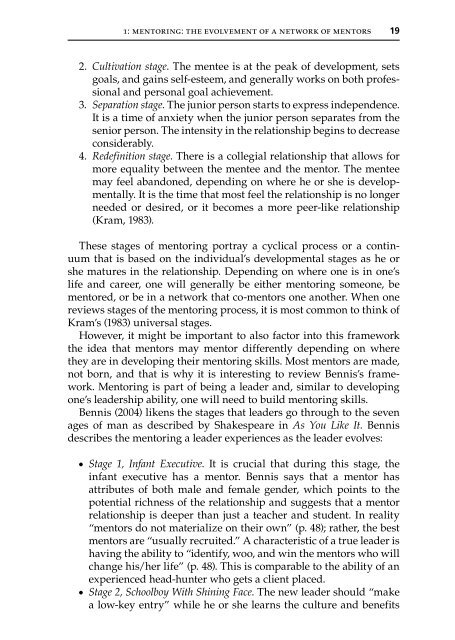Mentoring in Nursing - Springer Publishing
Mentoring in Nursing - Springer Publishing
Mentoring in Nursing - Springer Publishing
Create successful ePaper yourself
Turn your PDF publications into a flip-book with our unique Google optimized e-Paper software.
1: mentor<strong>in</strong>g: the evolvement of a network of mentors 19<br />
2. Cultivation stage. The mentee is at the peak of development, sets<br />
goals, and ga<strong>in</strong>s self-esteem, and generally works on both professional<br />
and personal goal achievement.<br />
3. Separation stage. The junior person starts to express <strong>in</strong>dependence.<br />
It is a time of anxiety when the junior person separates from the<br />
senior person. The <strong>in</strong>tensity <strong>in</strong> the relationship beg<strong>in</strong>s to decrease<br />
considerably.<br />
4. Redef<strong>in</strong>ition stage. There is a collegial relationship that allows for<br />
more equality between the mentee and the mentor. The mentee<br />
may feel abandoned, depend<strong>in</strong>g on where he or she is developmentally.<br />
It is the time that most feel the relationship is no longer<br />
needed or desired, or it becomes a more peer-like relationship<br />
(Kram, 1983).<br />
These stages of mentor<strong>in</strong>g portray a cyclical process or a cont<strong>in</strong>uum<br />
that is based on the <strong>in</strong>dividual’s developmental stages as he or<br />
she matures <strong>in</strong> the relationship. Depend<strong>in</strong>g on where one is <strong>in</strong> one’s<br />
life and career, one will generally be either mentor<strong>in</strong>g someone, be<br />
mentored, or be <strong>in</strong> a network that co-mentors one another. When one<br />
reviews stages of the mentor<strong>in</strong>g process, it is most common to th<strong>in</strong>k of<br />
Kram’s (1983) universal stages.<br />
However, it might be important to also factor <strong>in</strong>to this framework<br />
the idea that mentors may mentor differently depend<strong>in</strong>g on where<br />
they are <strong>in</strong> develop<strong>in</strong>g their mentor<strong>in</strong>g skills. Most mentors are made,<br />
not born, and that is why it is <strong>in</strong>terest<strong>in</strong>g to review Bennis’s framework.<br />
<strong>Mentor<strong>in</strong>g</strong> is part of be<strong>in</strong>g a leader and, similar to develop<strong>in</strong>g<br />
one’s leadership ability, one will need to build mentor<strong>in</strong>g skills.<br />
Bennis (2004) likens the stages that leaders go through to the seven<br />
ages of man as described by Shakespeare <strong>in</strong> As You Like It. Bennis<br />
describes the mentor<strong>in</strong>g a leader experiences as the leader evolves:<br />
●●<br />
●●<br />
Stage 1, Infant Executive. It is crucial that dur<strong>in</strong>g this stage, the<br />
<strong>in</strong>fant executive has a mentor. Bennis says that a mentor has<br />
attributes of both male and female gender, which po<strong>in</strong>ts to the<br />
potential richness of the relationship and suggests that a mentor<br />
relationship is deeper than just a teacher and student. In reality<br />
“mentors do not materialize on their own” (p. 48); rather, the best<br />
mentors are “usually recruited.” A characteristic of a true leader is<br />
hav<strong>in</strong>g the ability to “identify, woo, and w<strong>in</strong> the mentors who will<br />
change his/her life” (p. 48). This is comparable to the ability of an<br />
experienced head-hunter who gets a client placed.<br />
Stage 2, Schoolboy With Sh<strong>in</strong><strong>in</strong>g Face. The new leader should “make<br />
a low-key entry” while he or she learns the culture and benefits
















